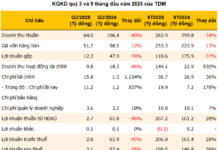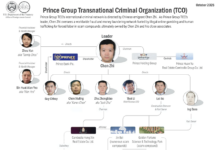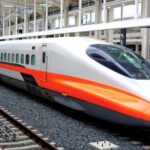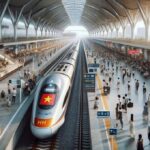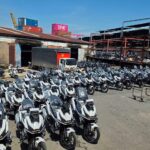
Distinguished guests attending the seminar (from left to right): Director-General of Vietnam Railways, Hoang Gia Khanh; Permanent Member of the National Assembly’s Economic Committee, Phan Duc Hieu; Deputy Minister of Planning and Investment, Tran Quoc Phuong; Deputy Minister of Finance, Bui Van Khang; and Deputy Minister of Transport, Nguyen Danh Huy.
|
At the seminar “High-Speed Rail: Opportunities and Challenges,” government officials and experts analyzed, discussed, and clarified issues of public interest regarding the proposed high-speed rail investment project on the North-South axis, including financing, speed, and economic and social impact.
High-speed rail is expected to increase GDP by approximately 0.97 percentage points.
Regarding the timing of the proposal to build the North-South high-speed rail line, Deputy Minister of Transport, Nguyen Danh Huy, shared that the Ministry of Transport has spent 18 years researching high-speed rail development.
Based on transport demand forecasts, the Ministry of Transport believes that now is an appropriate and necessary time to construct the North-South high-speed rail line to restructure the transport market share. Additionally, with Vietnam’s economy reaching a scale of $430 billion and manageable public debt, the Minister of Finance, Bui Van Khang, affirmed that the country’s financial resources are not a significant challenge.
Technically, the Ministry of Transport has justified the choice of a speed of 350 km/h and its focus on passenger transport over freight. These decisions were informed by ten years of research and collaboration with international experts and interdisciplinary delegations that studied high-speed rail systems in six developed countries.
“Now is the opportune time for the Central Executive Committee and the Politburo to decide on presenting it to the National Assembly for consideration and investment approval,” asserted Deputy Minister Nguyen Danh Huy. “This will also serve as a premise and motivation for us to embark on an era of advancement, as General Secretary To Lam has envisioned.”
Echoing the sentiments of the Ministry of Transport, Deputy Minister of Planning and Investment, Tran Quoc Phuong, emphasized the political and practical foundations for constructing the high-speed rail line by 2035. He referenced resolutions and conclusions of the Central Committee and the Politburo, highlighting the necessity of infrastructure development, including the North-South high-speed rail line, to achieve a breakthrough in infrastructure and positively impact economic growth and social welfare.
“Investment spending also stimulates economic growth,” he added. “In the history of public investment in Vietnam, this project has the largest scale, with an estimated total investment of nearly $70 billion. This is a substantial amount, and its impact on economic growth during the construction period is expected to increase GDP by approximately 0.97 percentage points, according to preliminary assessments. This contribution is significant for the country’s overall economic growth.”
Specifically, the leader of the Ministry of Planning and Investment believes that, from the moment of agreement on the high-speed rail line construction, at least seven sectors will be positively affected: construction; auxiliary industries (materials, steel, and supporting industries); financial services (banking and credit mobilization); urban development; tourism; employment; and transport and logistics.
“The high-speed rail line will have a positive impact if we do it well and quickly,” said Deputy Minister Tran Quoc Phuong. “The investment will directly impact GDP in the initial phase, and its diffusion effect will be even more significant later, possibly surpassing our current calculations.”
From a researcher’s perspective, Permanent Member of the National Assembly’s Economic Committee, Phan Duc Hieu, shared his thoughts on the public’s concerns about train speeds of 250 km/h or 350 km/h and the focus on passenger or freight transport. He supported the technical option of a maximum speed of 350 km/h for passenger transport and a 22.5-ton axle load proposed by the Ministry of Transport, believing it to be optimal and forward-thinking. He explained that this option meets future demands for transportation, scientific and technological advancements, and minimizes the need for costly upgrades and adjustments after completion.
Hoang Gia Khanh, Director-General of Vietnam Railways, who has a long association with the railway sector, offered his insights: “Once established, the high-speed rail will play a pivotal role in integrating the five primary transport modes: road, rail, maritime, aviation, and inland waterways, along the North-South axis. This integration will not only leverage the strengths of each mode but also optimize the transportation system, reduce logistics costs, and enhance the competitiveness of the economy. Flexible and cost-effective freight transportation will contribute to socio-economic development.”
“The first strength of high-speed rail is its excellent safety record, as evidenced by Japan’s Shinkansen, which has operated since 1964 without any accidents. Other countries with high-speed rail systems have also maintained impressive safety standards,” Mr. Hoang Gia Khanh continued. “Secondly, travel time is precisely calculated to the minute. Thirdly, high-speed rail offers convenience and comfort, providing passengers with spacious cabins and easy onboard mobility. Additionally, centrally located stations in populated areas enhance accessibility compared to other transport options. Furthermore, the electrification of high-speed rail makes it environmentally friendly and efficient.”
Financing for the project is ready
Regarding the financial resources for the project, Deputy Minister of Finance, Bui Van Khang, assured that the financial preparations for the high-speed rail project are on track to ensure the highest level of financial resources according to the approved timeline and implementation progress, aligning with the Resolution 49-NQ/TW of the Politburo and the resolutions of the Central Committee.

Deputy Minister of Finance, Bui Van Khang – Photo: VGP/Duong Tuan
|
According to the Ministry of Finance, various ministries and sectors have closely coordinated and agreed upon three groups of overall solutions and four groups of resource mobilization methods.
The three groups of overall solutions include: Innovating the growth model and flexibly and effectively managing socio-economic development to increase annual state budget revenue, with the spirit of achieving higher revenue each year than the previous year; Implementing a flexible and efficient fiscal policy by streamlining and preventing wastefulness to focus resources on development investment; and Reforming institutions and removing bottlenecks and obstacles in attracting resources in the fields of finance and investment.
The four groups of resource mobilization methods comprise: First, formulating a five-year national financial plan for the three phases up to 2035, proactively balancing resources, and prioritizing development investment, especially for national and key transport sector projects, including the high-speed rail project. This will involve a combination of central and local budgets, with the central budget playing a leading role.
Second, attracting resources and issuing government bonds with appropriate interest rates and maturities, considering market conditions and project implementation progress. Third, mobilizing domestic resources, including through public-private partnerships. Fourth, seeking concessional external resources with favorable conditions, reasonable negotiation terms, and minimal constraints.
Addressing concerns that concentrating significant resources on high-speed rail construction would affect investment in other sectors, Deputy Minister Bui Van Khang explained that the Ministry of Finance would proactively build financial scenarios based on annual budget revenue and expenditure performance. These scenarios will be carefully calculated and scientifically viable, considering strategic priorities in each phase. The investment budget for the three phases will be planned comprehensively, ensuring a balance with projects in other sectors and aligning with the Party’s directives, the National Assembly’s orientations, and the Government’s flexible management.
Additionally, the resource allocation will also ensure a balance between tasks for national targets, key programs, and economic priorities, following the Party’s guidance, the National Assembly’s orientations, and the Government’s flexible management.
Developing special mechanisms and policies across five areas
Prime Minister Pham Minh Chinh has instructed the Ministry of Transport to review the investment rate for the high-speed rail project and propose special mechanisms, especially regarding resource mobilization, procedures, land policies, site clearance, and material sources. On this matter, Deputy Minister Nguyen Danh Huy shared that as this project is exceptionally large-scale and involves new technology, the Ministry of Transport has proactively developed a system of mechanisms and policies, which the Government has approved for submission to the National Assembly. These include 19 mechanisms and policies under the National Assembly’s authority and five under the Government’s authority, focusing on five areas.
The first area aims to ensure feasibility and accelerate project implementation by facilitating timely site clearance, selecting reputable contractors, and engaging international consultants to access global knowledge and experience, thereby ensuring successful project execution.
The second area focuses on mechanisms and policies to guarantee sufficient and flexible resource mobilization. The third area involves enhancing decentralization and delegation of authority, coupled with rigorous monitoring and supervision. The fourth area centers on human resource development policies, and the fifth area targets policies to foster the development of the railway industry.
Notably, in developing the proposal, the Ministry of Transport has designed mechanisms and policies to enable the participation of domestic enterprises in the project. The Ministry will set conditions for the general contractor, requiring the use of domestically produced goods and services as a prerequisite for contractor eligibility. Additionally, policies will be presented to the National Assembly, mandating state-owned enterprises or placing orders with domestic enterprises for items and goods that can be produced locally.
“In the construction sector, we have mastered road construction, including complex structures and tunnels. We are confident that Vietnamese enterprises can participate and eventually take ownership,” affirmed the Deputy Minister of Transport.
Concurring with the policies proposed by the Ministry of Transport, Deputy Minister of Planning and Investment, Tran Quoc Phuong, emphasized that these special mechanisms are not limited, and we are committed to giving the highest priority to the implementation of this project. He added that matters within the authority of a particular level should be presented to that level, accompanied by an analysis of the effectiveness of the special mechanisms.
Unlocking New Frontiers: The North-South High-Speed Rail Project.
On the afternoon of October 14th, a council meeting was held at the Ministry of Planning and Investment headquarters. The meeting was attended by the State Appraisal Council, who reviewed the pre-feasibility study report for the high-speed North-South railway project. Minister of Planning and Investment Nguyen Chi Dung, as the Chairman, presided over the meeting.
Clarifying the Localization Potential of the High-Speed North-South Railway
“A critical evaluation of the pre-feasibility study report for the high-speed North-South railway project is warranted. The Ministry of Planning and Investment has requested the Ministry of Transport to elucidate the potential for enhanced localization and technological mastery. Furthermore, a comprehensive assessment of the advantages of public investment compared to alternative financing models, especially for sections without a discernible advantage for railway development, is imperative.”
The City of Rails: An Opportunity to Embrace
High-speed rail lines are not just a transport project of paramount importance; they present a unique opportunity to redefine urban planning and catalyze development.











